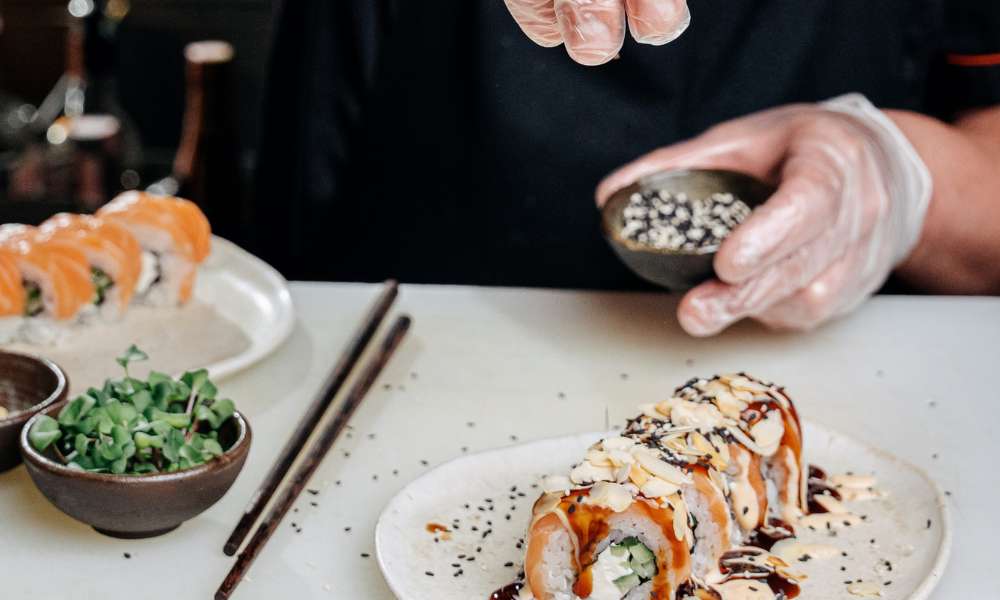Sushi, an emblematic Japanese dish, has transcended its cultural roots to attain global adoration. Beyond the surface of this delicate and artistic cuisine, commonly linked with raw fish and rice, lies a profound depth. The creation of sushi is not merely a culinary task; it is an intricate craft, perfected by sushi chefs through extensive years of training. In the following exploration, we will unravel the meticulous process of crafting sushi, delving into its diverse ingredients, intricate techniques, and the cultural significance that underlies this exquisite culinary art form. Guiding us through this culinary journey is Masuta Japanese Fusion Restaurant, adding its unique perspective to the rich tapestry of sushi creation.
Understanding the Basics: Ingredients and Types
Ingredients: The Foundation of Sushi
The primary components of sushi are sushi rice (shari), raw fish, and nori (seaweed). However, sushi’s beauty lies in its versatility and the endless combinations of ingredients that can be used, including various types of seafood, vegetables, and even fruits.
Sushi Rice: The key to perfect sushi rice lies in its preparation. Chefs use a specific type of short-grain rice, seasoned with a blend of vinegar, sugar, and salt. The rice must be cooked to the right consistency – sticky yet individual grains can be discerned.
Fish and Seafood: Traditionally, sushi features raw fish like salmon, tuna, and mackerel. The fish must be fresh and of the highest quality. Sushi chefs are skilled in slicing fish in ways that enhance its flavor and texture.
Nori and Other Ingredients: Nori, the seaweed wrapper used in rolls, adds a distinct flavor and texture. Other ingredients like cucumber, avocado, and pickled radish introduce additional flavors and textures.
Types of Sushi: A Diverse Palette
- Nigiri: Hand-pressed rice topped with a slice of raw fish.
- Maki: Rolled sushi with rice and fillings wrapped in nori.
- Sashimi: Thinly sliced raw fish, served without rice.
- Temaki: Hand-rolled nori cones filled with rice and various ingredients.
The Art of Making Sushi
Rice Preparation: The Heart of Sushi
Preparing sushi rice is a ritualistic process. The rice is washed multiple times until the water runs clear, then cooked precisely. Once cooked, it’s seasoned with a vinegar mixture and fanned to achieve the perfect temperature and texture.
Fish Cutting: Precision and Skill
The cutting of fish for sushi is an art. Each type of fish requires a different cutting technique. The aim is to enhance the fish’s natural flavor and texture. The slices must be thin yet substantial, allowing the fish to melt in the mouth while retaining its integrity.
Assembly: Where Art Meets Culinary Skill
- Nigiri: A small ball of rice is formed by hand, and a slice of fish is draped over it. The chef might apply a touch of wasabi between the rice and fish.
- Maki: A bamboo mat (makisu) is used to roll the nori filled with rice and other ingredients into a tight cylinder, then sliced into pieces.
- Temaki: The nori is filled and rolled by hand into a cone shape, allowing for a more casual and personalized eating experience.
Cultural Significance and Etiquette
Sushi is not just food; it’s a reflection of Japanese culture and aesthetics. The presentation is as important as the taste. Each piece is crafted to please the eye and the palate. Sushi chefs train for years to master their craft, and their skills are revered.
When eating sushi, it’s customary to use your hands or chopsticks. It’s recommended to eat sushi in one bite to enjoy the harmony of flavors and textures. Soy sauce and wasabi are used sparingly to not overpower the delicate taste of the fish.
Conclusion: More Than Just a Meal
Sushi is an experience, a journey through taste, texture, and tradition. It embodies the Japanese principle of simplicity and attention to detail, where each element, from the rice to the fish, plays a crucial role in the final creation. This culinary art form requires not only technical skills but also an understanding of the ingredients’ inherent qualities.
Embark on a culinary odyssey within the captivating world of Masuta Japanese Fusion. Discover a harmonious blend of flavors that not only respects sushi’s historical roots but also caters to the modern palate. Visit us at 1712-1714 Sheepshead Bay Rd, Brooklyn NY 11235, and immerse yourself in a dining experience that transcends boundaries, awakening your senses to a seamless integration of diverse tastes, cultural influences, and culinary traditions. Masuta Japanese Fusion invites you to savor an exceptional journey where the past and present converge in every delectable bite.



